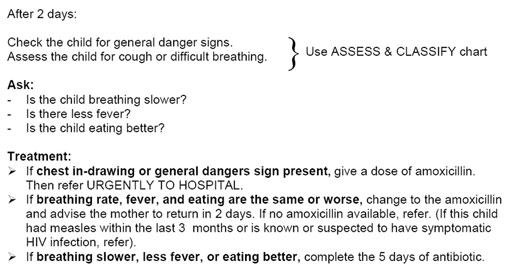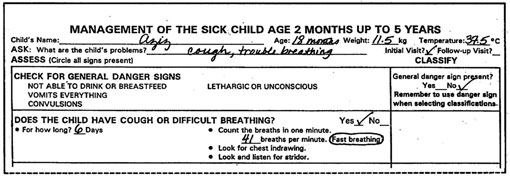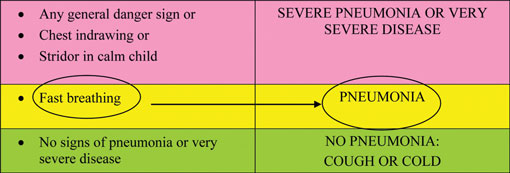4.4 Follow-up care for pneumonia
If a child has been classified with pneumonia, it is important that the mother is told to return to the health post in two days’ time for a follow-up visit. You should assess the child for cough or difficult breathing in the way outlined in Box 4.4.
![]() You should always refer a child to hospital if there are general danger signs or chest in-drawing.
You should always refer a child to hospital if there are general danger signs or chest in-drawing.
Box 4.4 Follow-up care for pneumonia
The following case study will help you check your understanding of what you have read so far in this study session.
Case Study 4.1 Aziz’s case
Aziz is 18 months old. He weighs 11.5 kg. His temperature is 37.5°C. His mother brought him to the health post because he had cough. She says he was having trouble breathing. This is his initial visit for this illness.
The Health Extension Practitioner checked Aziz for general danger signs. Aziz was able to drink. He had not been vomiting. He had not had convulsions. He was not convulsing, lethargic or unconscious.
The Health Extension Practitioner asked the mother, ‘How long has Aziz had this cough?’ His mother said that Aziz had been coughing for six or seven days. Aziz sat quietly on his mother’s lap. The Health Extension Practitioner counted the number of breaths the child took in a minute and counted 41 breaths. She thought, ‘Since Aziz is over 12 months of age, the cut-off for determining fast breathing is 40. He has fast breathing’.
The Health Extension Practitioner did not see any chest in-drawing. She did not hear stridor.
The chart below shows you how the Health Extension Practitioner recorded Aziz's case information and signs of illness:
To classify Aziz’s illness, the Health Extension Practitioner looked at the classification table for coughs or difficulties in breathing.
First she checked to see if Aziz had any of the signs in the pink row. She considered, ‘Does Aziz have any general danger signs? No, he does not. Does Aziz have any of the other signs (chest in-drawing and stridor in a calm child) in this row? No, he does not. Therefore Aziz does not have any of the signs for severe pneumonia or very severe disease.’
Next, the Health Extension Practitioner looked at the yellow (middle) row. She thought, ‘Does Aziz have signs in the yellow (middle) row? He has fast breathing.’
The Health Extension Practitioner classified Aziz as having pneumonia and she wrote this down on the Recording Form (see below).
In this study session you have learned how to assess and classify cough or difficult breathing in children under five years. You looked at how to treat the sick child, when you need to refer a child urgently to hospital, what follow-up care is required, and what advice on home treatment you should give to the mother or child’s caregiver.
4.3.3 Treatment for no pneumonia: cough or cold



